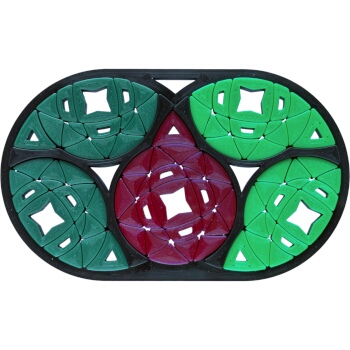|
Three intersecting circles. Two rotating in steps of 120° and one (jumbling) in steps of 45°.
Acrux is the brightest star in the southern constellation of Crux. It has the Bayer designation α Crucis, which is Latinised to Alpha Crucis and abbreviated Alpha Cru or α Cru. With a combined visual magnitude of +0.76, it is the 13th-brightest star in the night sky. It is the most southerly star of the asterism known as the Southern Cross and is the southernmost first-magnitude star, 2.3 degrees more southerly than Alpha Centauri. This system is located at a distance of 321 light-years from the Sun. To the naked eye Acrux appears as a single star, but it is actually a multiple star system containing six components. Through optical telescopes, Acrux appears as a triple star, whose two brightest components are visually separated by about 4 arcseconds and are known as Acrux A and Acrux B, α1 Crucis and α2 Crucis, or α Crucis A and α Crucis B. Both components are B-type stars, and are many times more massive and luminous than the Sun. α1 Crucis is itself a spectroscopic binary with components designated α Crucis Aa (officially named Acrux, historically the name of the entire system) and α Crucis Ab. Its two component stars orbit every 76 days at a separation of about 1 astronomical unit. HR 4729, also known as Acrux C, is a more distant companion, forming a triple star through small telescopes. C is also a spectroscopic binary, which brings the total number of stars in the system to at least five. The historical name Acrux for α1 Crucis is an "Americanism" coined in the 19th century, but entering common use only by the mid 20th century. The two components, α1 and α2 Crucis, are separated by 4 arcseconds. α1 is magnitude 1.40 and α2 is magnitude 2.09, both early class B stars, with surface temperatures of about 28,000 and 26,000 K, respectively. Their luminosities are 25,000 and 16,000 times that of the Sun. α1 and α2 orbit over such a long period that motion is only barely seen. From their minimum separation of 430 astronomical units, the period is estimated to be around 1,500 years. α1 is itself a spectroscopic binary star, with its components thought to be around 14 and 10 times the mass of the Sun and orbiting in only 76 days at a separation of about 1 AU. The masses of α2 and the brighter component α1 suggest that the stars will someday explode as supernovae. Component Ab may perform electron capture in the degenerate O+Ne+Mg core and trigger a supernova explosion, otherwise it will become a massive white dwarf. Acrux is represented in the flags of Australia, New Zealand, Samoa and Papua New Guinea as one of five stars which comprise the Southern Cross. It is also featured in the flag of Brazil, along with 26 other stars, each of which represents a state; Acrux representing the state of São Paulo. It is also represented (as part of the Southern Cross) on the cover of the current (from 2015) Brazilian passport. The inventor designed it as a successor to his own Aldebaraan puzzle. Size: 110 x 181 mm Contributors
No one has contributed to this page yet! Collections No one has added this puzzle to a collection yet! Found a mistake or something missing? Edit it yourself or contact the moderator. |
|




